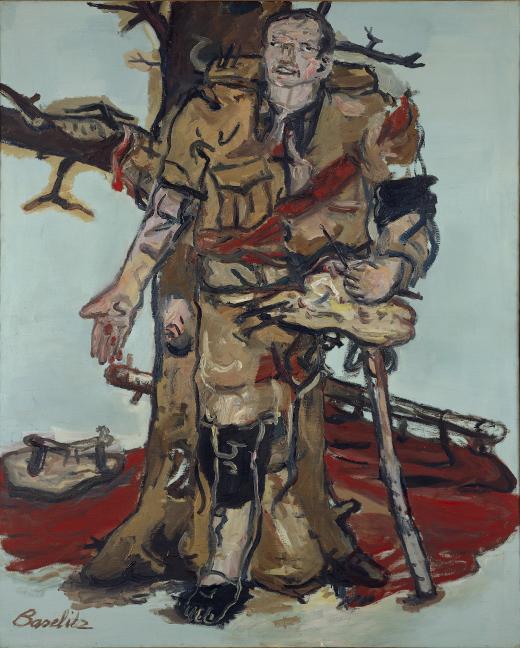BLOCKED PAINTER (VERSPERRTER MALER), 1965
The majority of figures in this series are wearing uniforms. A person in uniform may be surrendering their own individuality, yet at the same time they demonstrate membership of an organisation or association, and outwardly display their status. Yet in this series of works, such meanings soon dissolve in the face of these uniforms, tattered and torn – their individual ragged states also subverting the ideal of equality and a protective community. Baselitz’s uniforms, though, are not sheer fantasy, but based on real models.
"In the period that followed, there was a fashion – perhaps an obsessive fashion – to wear army uniforms, and not only in Germany, but also in France – since we bought the uniforms in Germany… I mean, in France. It was the ‘military look’ and at the Paris flea market – quite seriously – you could find a vast arsenal of used uniforms. And all the women – my wife as well – and the guys – we all went shopping there, bought this stuff and wore it. So if you wanted to be en vogue in Berlin, you wore army clothing, predominantly American, and from the Korean war or Vietnam war. But I didn’t know all that at the time I was painting these works. They say that artists always have something visionary – and I sensed that something like that was going to happen. In reality, if you take the books literally which I just mentioned, naturally it was people who were in the White Russian army, in the Soviet Red Army, and then the so-called ‘green army’, the forest army of partisans, and so on. And if they didn’t wear armbands – at the very least armbands – , they wore some kind of uniform. It wasn’t a fantasy uniform like D’Annunzio, but one that could be found hundreds, thousands of times – depending on how large the body of troops was. And the uniform colour is what is called field grey or mouse grey, or a kind of earth ochre, and the works always move between these colours. What’s noticeable with all the figures I painted is that they hardly look at all – let’s say – as if they are properly wearing a uniform. Instead, the uniforms are ragged, the clothing is torn, the trousers are torn, with the trousers often falling down and so on – so it depicts a fairly wretched state.
And that wretched state is visible across the entire picture. So all the props in the image show signs of destruction – the trees are kaput, the houses are kaput, the fields are kaput, the objects are kaput. Nothing can actually be fully utilised.And that wretched state is visible across the entire picture. So all the props in the image show signs of destruction – the trees are kaput, the houses are kaput, the fields are kaput, the objects are kaput. Nothing can actually be fully utilised.“

